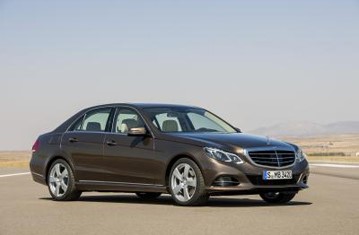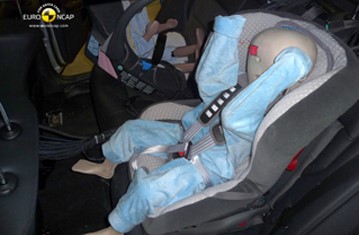Find more information in the General Comments section of the assessment
Find more information in the Rating Validity tab of the assessment
- See More
- See More
- See More
- See More
- Good
- Adequate
- Marginal
- Weak
- Poor
 Passenger
Passenger
 Driver
Driver
 Front Seat
Front Seat
 Car
Car
 Pole
Pole
- Good
- Adequate
- Marginal
- Weak
- Poor


Passenger
outboard
center
Fitted to the vehicle as standard
Not fitted to the test vehicle but available as option
Not Available
In the frontal impact, forward movement of the head of the 3 year dummy was not excessive. In the side barrier impact, the head of the 3 year and 18 month infant were properly contained within the protective shell of the CRS. Neither dummy recorded values in the test which would reflect poor protection. Rearward facing child restraints sold by Mercedes Benz are automatically detected by the front passenger seat and the airbag for that seating position is disabled. However, other rearward facing child restraints would not be recognised by the system and the airbag remains active. The car contains a permanent label, clearly warning of the potential dangers of using a rearward facing CRS without disabling the passenger airbag.
- Good
- Adequate
- Marginal
- Weak
- Poor

Head Impact 15.2 Pts
Pelvis Impact 0.0 Pts
Leg Impact 6.0 Pts
New pedestrian tests were needed to update the rating of the E Class to 2010. The bumper scored maximum points for the protection it offered to pedestrians' legs. However, the front edge of the bonnet was rated as poor. The E-Class is equipped with a pop-up bonnet, giving greater clearance between the bonnet surface and the rigid components of the engine compartment when the car senses that it is striking a pedestrian. Good protection was provided in most parts of the bonnet likely to be struck by a child's head and in many of the areas where an adult's head might strike.
- Good
- Adequate
- Marginal
- Weak
- Poor
| System Name | ESP | |
| Performance | ||
| Applies To | All seats | ||
| Warning | Driver Seat | Front Passenger(s) | Rear Passenger(s) |
| Visual | |||
| Audible | |||
|
|||
The E Class is equipped with Electronic Safety Control (ESC) as standard equipment on all variants. A seatbelt reminder system, covering both front and rear seats, is also standard equipment.
- Specifications
- Safety Equipment
- Videos
- Advanced Rewards
- Rating Validity
Specifications
Tested Model Mercedes-Benz E220 CDI 'Avantgarde', LHD
Body Type - 4 door saloon
Year Of Publication 2010
Kerb Weight 1735kg
VIN From Which Rating Applies - WDD21200511A133988
Class Executive Car
Safety Equipment
Note: Other equipment may be available on the vehicle but was not considered in the test year.
Fitted to the vehicle as standard
Fitted to the vehicle as option
Not fitted to the test vehicle but available as option
Not Available
Not Applicable
Videos
Advanced Rewards
Rating Validity


Find more information in the General Comments section of the assessment
The rating of the Mercedes E Class has been upgraded from 2009 to 2010. The car is unchanged and, apart from the pedestrian tests which have been repeated, test results have been carried over from the previous year. However, the thresholds for the different star ratings have been increased and this assessment shows how the car rates against the more demanding 2010 requirements.
 Share
Share










The E Class is fitted as standard with Mercedes Benz's 'PRE SAFE'' system which senses when an accident is about to occur and primes the restraint and protection systems in readiness for the collision. In Euro NCAP’s frontal and side barrier impacts, the PRE-SAFE System was not activated. The passenger compartment remained stable in the frontal impact, the windscreen pillar moving rearwards by only 3mm. Dummy readings indicated good protection of the knees and femurs of both driver and passenger. Mercedes were able to demonstrate that occupants of different sizes, and those sat in different seating positions, would have a similar level of protection against upper leg injuries. Maximum points were scored in the side barrier test. In the more severe side pole test, protection offered by the chest was rated as marginal. Protection against whiplash injuries in a rear impact was also rated as marginal.